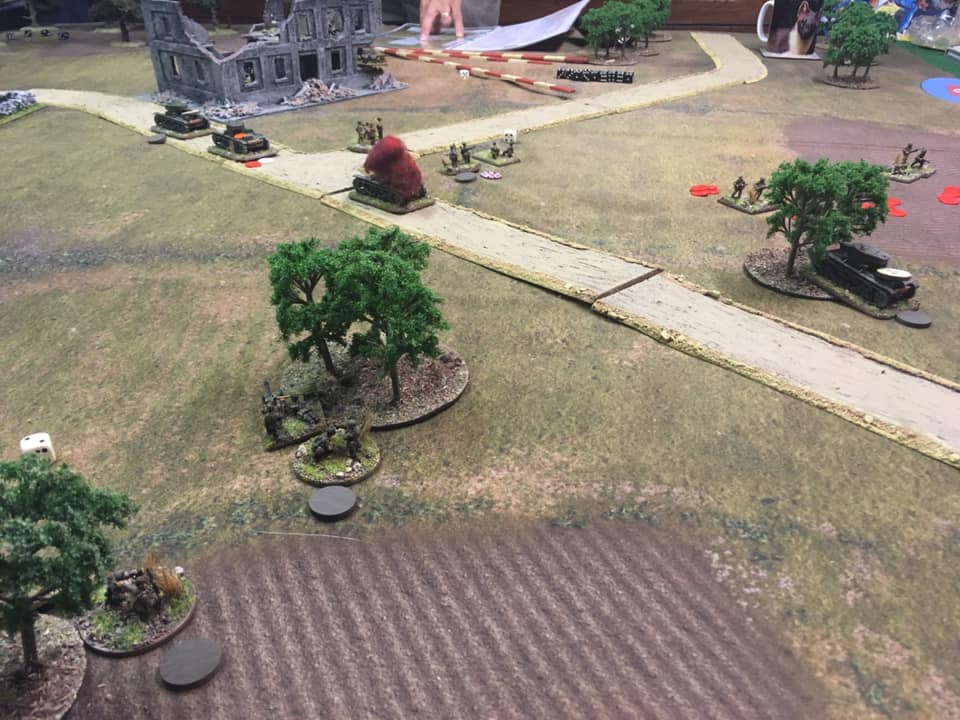

Ridgeline from the Southwest
I stole this scenario from a couple of websites that had AARs of "Lets Get the Bastards' game 12 from the TFL book "Cymru Am Byth" This is an attack for control of the little cluster of farm buildings on top of hill 242 overlooking Chenedolle at Le Haut Perrier on August 11, 1944.
What I really liked about this scenario was three troops of 3rd Scots Guards Churchill tanks in a Normandy setting.

View from the Southeast
The German defenders from the 9th SS Hohenstauffen Division held the ridgeline which went across the table and sloped down to the north.
There was an infantry element of three weak platoons (only two 6-man sections each) that could be dug in; two off-board 8cm mortars; and three Big Men: two Level III, one Level l.
The Armour group had six Panthers, three of which had to start dug in.

View from the Northeast
The attacking players came in on the north edge. They had the 3rd Company, Welsh Guards. Standard three platoons with a Level IV and three Level III leaders, and two dummy Blinds.
The armour was three troops from the 3rd Scots Guards, with six Mark VI Churchills, a CS tank and two Mk VIIs.

View from the Northwest
The main route up the ridge went past a farm and had a sunken road split off to the left that went across the table. Other hedges were just a thick line of bushes.

Commonwealth attackers
Barry had the armour, Rob was the senior advisor, and Charles took the Welsh infantry. Only Rob had played IABSM before.

German defenders
Randy had the Panthers, Sebastian the Grenadiers, and Chris was the senior advisor.

Churchills going down the sunken road
Barry sent one troop up the road towards the hamlet, and another left down the lane scattering the Welsh who were using it for cover. A random event immobilized the CS tank almost immediately.

Churchills advance cautiously up the road
The Welsh seemed to have gotten stuck back in the sunken road. In the next phase, this Churchill will take a hit from the Panthers at the farm.

Dug in Panthers
They had a good view over most of the board and started firing at the Churchills as they came on table.

Panthers waiting at the top of the ridge farm
And sniping at the lead Churchill.

Great field of fire
When they no longer had Churchills in sight they started shooting at the Welshmen.

Welsh using the lane as hard cover
And scattering out of the way as another troop of Churchills (under the Blind) heads east. The stalled CS tank is burning now after multiple hits from the Panthers. A lone section heads up the ridge to draw fire as the rest of the platoon waits on overwatch.

Churchills looking for a path up
Barry would run up a tank take a shot then pull back before the Panthers could retaliate. Unfortunately this did not lead to any damage to the Panthers.

First attack on the ridge buildings
The lead Churchill is damaged. The 2" mortars are trying to block the AP fire. One section is pinned moving up the lane and another platoon moves up to the orchard's wall under fire from the top floor of the buildings. These would be Poor shots due to all the intervening terrain, but whenever the Welsh hit they scored a kill. Sebastian seemed to only be able to roll '6' for his casualties.

Another view...
…of the firing through the orchard.

Churchills on the left
A second troop of Churchills moves up under the Blinds and the first troop moves further east to the end of the sunken part of the lane.

Churchills trying to outflank the Panthers
Or at least get them to move out of their dug outs. Randy did move one from his left across to the red tiled building. Someone is using their laser range finder to look for exposed Churchills. Could explain the superior German marksmenship.

Another Churchill hit
When the got further left (east) they could be seen and shot at from the top of the ridge.

Fight continues on the road
German mortars coming down now. Only one Churchill left here and that is immobilized. They Grenadiers in the buildings have been neutralized with head shots thanks to Sebastian's rolls.

Welsh getting ready to advance into the buildings
But they also spot a minefield to their front in the next field.

Welsh pinned on the left
Combined MG fire from the dug in grenadiers and panthers have pinned the Welsh in the buildings.

Churchills trying to hit some Panzers
But their combined fire wasn't enough to do much damage to the hull down Panthers.

Furtherest advance of the Welsh
They took at least three PIAT shots on the Panthers in the farm from the orchard but were unable to get any further. All three platoon leaders down: they had no juice left.
Final casualties for the Welsh were thirty-one plus the three Big Men. Most Churchills were out of action at this point. The Germans had eleven casualties and one uncommitted platoon. Minor damage on the Panthers.
Inexperienced really showed as the Welsh infantry did not coordinate their fire and movement and had no inter-working among players. Tanks wanted to go left and infantry used the covered approaches to get close to their objective.






















































































































































































































